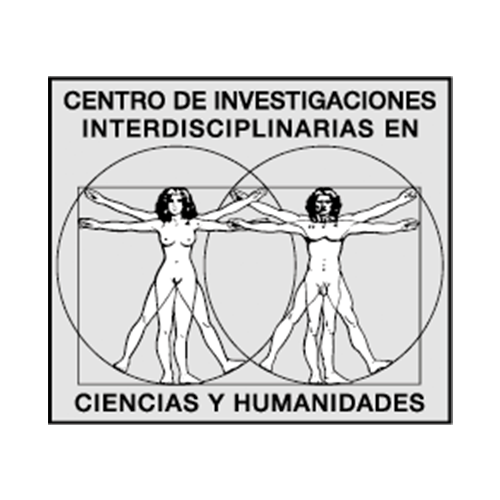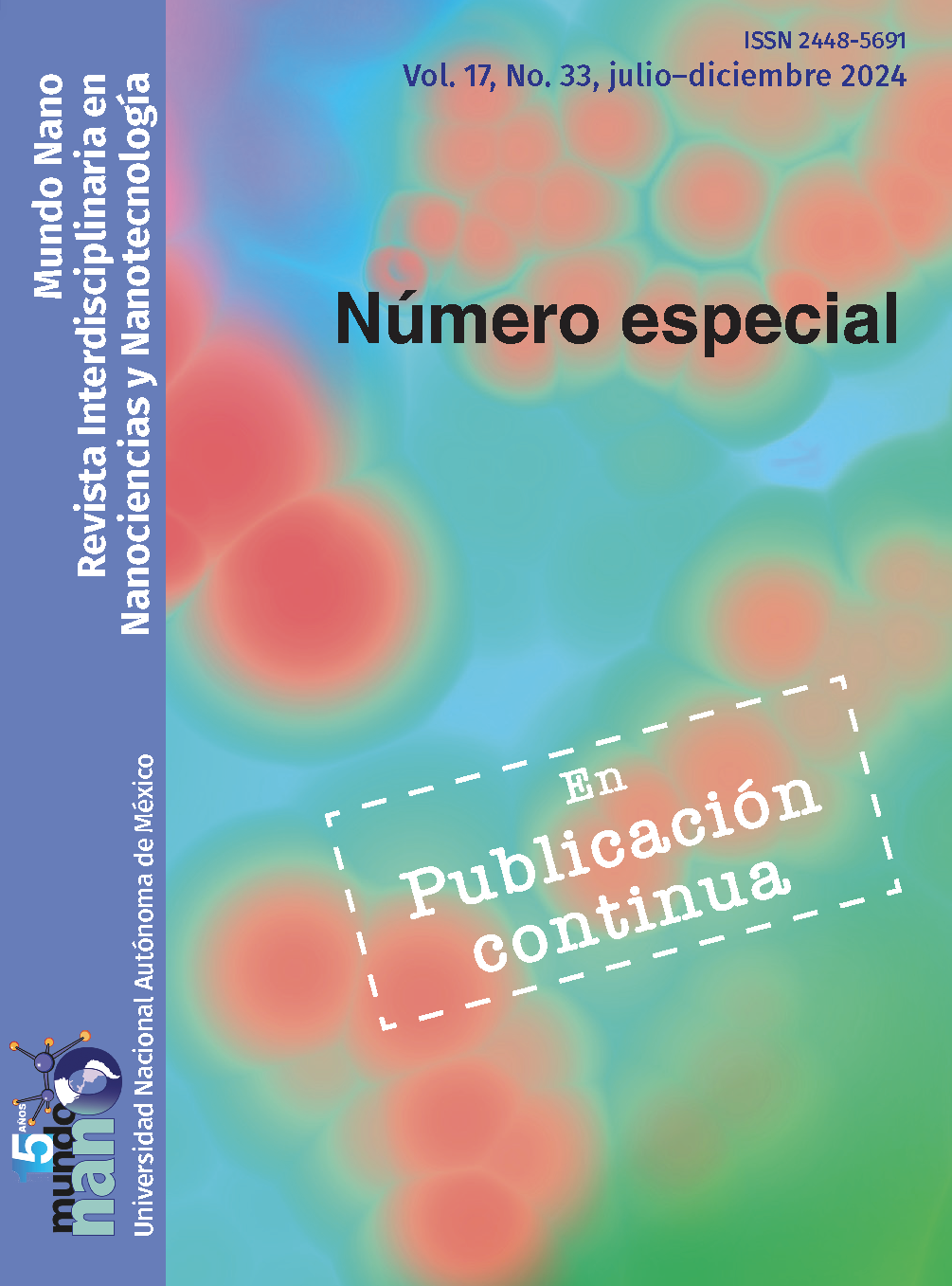A review of gold nanoparticles: physicochemical properties and their cellular response in macrophages
Main Article Content
Abstract
The study of nanomaterials (NMs) and their physicochemical properties such as size, chemical nature, composition and shape is of paramount importance. Specifically, gold nanoparticles (AuNPs) and their shapes such as rollers, spheres and cubes, are used in the biomedical field, for example, nanostars and gold cubes have a great resonance effect of the localizing surface plasmon (LSPR) allowing them to be used in diagnosis, marking and tumor therapies; however, the latter lack or have few in vitro toxicological studies to ensure their biocompatibility. This review mentions the main characteristics of AuNPs that allow them to be used in these therapies and some of the cell studies that have been carried out with them in macrophage cultures to obtain adequate concentrations for their future medical application.
Downloads
Article Details

Mundo Nano. Revista Interdisciplinaria en Nanociencias y Nanotecnología por Universidad Nacional Autónoma de México se distribuye bajo una Licencia Creative Commons Atribución-NoComercial 4.0 Internacional.
Basada en una obra en http://www.mundonano.unam.mx.
References
Abuarqoub, Duaa, Nouf N. Mahmoud, Rand Zaza, Rana Abu-Dahab, Enam A. Khalil y Dima A. Sabbah. (2022). The in vitro immunomodulatory effects of gold nanocomplex on THP-1-derived macrophages. Journal of Immunology Research, (febrero): 1-8. https://doi.org/10.1155/2022/6031776.
Adewale, Olusola B., Hajierah Davids, Lynn Cairncross y Saartjie Roux. (2019). Toxicological behavior of gold nanoparticles on various models: influence of physicochemical properties and other factors. International Journal of Toxicology, 38(5): 357-84. https://doi.org/10.1177/1091581819863130.
Ahmed, Wajiha, Haolan Zhang y Changyou Gao. (2022). Influence of enantiomeric polylysine grafted on gold nanorods on the uptake and inflammatory response of bone marrow‐derived macrophages in vitro. Journal of Biomedical Materials Research Part A, 110(1): 143-55. https://doi.org/10.1002/jbm.a.37272.
Andrea Barrios, Gumiel. (2020). Síntesis y aplicaciones de sistemas dendríticos nanoestructurados mediante procesos de dendronización. Tesis doctoral. Universidad de Alcalá, 1-2.
Arnida, M. M. Janát-Amsbury, A. Ray, C. M. Peterson y H. Ghandehari. (2011). Geometry and surface characteristics of gold nanoparticles influence their biodistribution and uptake by macrophages. European Journal of Pharmaceutics and Biopharmaceutics, 77(3): 417-23. https://doi.org/10.1016/j.ejpb.2010.11.010.
Blog oficial del Dr. Juan Carlos Vázquez Lira. Fisicoquímica interactiva. https://blogceta.zaragoza.unam.mx/fisico-qa/.
Carlander, Ulrika, Klara Midander, Yolanda S. Hedberg, Gunnar Johanson, Matteo Bottai y Hanna L. Karlsson. (2019). Macrophage-assisted dissolution of gold nanoparticles. ACS Applied Bio Materials, 2(3): 1006-16. https://doi.org/10.1021/acsabm.8b00537.
Carnovale, Catherine, Gary Bryant, Ravi Shukla y Vipul Bansal. (2019). Identifying trends in gold nanoparticle toxicity and uptake: size, shape, capping ligand y biological corona. ACS Omega, 4(1): 242-56. https://doi.org/10.1021/acsomega.8b03227.
Chen, Xinyi y Changyou Gao. (2017). Influences of size and surface coating of gold nanoparticles on inflammatory activation of macrophages. Colloids and Surfaces B: Biointerfaces, 160(diciembre): 372-80. https://doi.org/10.1016/j.colsurfb.2017.09.046.
Dey, Arindam K., Alexis Gonon, Eve-Isabelle Pécheur, Mylène Pezet, Christian Villiers y Patrice N. Marche. (2021). impact of gold nanoparticles on the functions of macrophages and dendritic cells. Cells, 10(1): 96. https://doi.org/10.3390/cells10010096.
Ding, Xianguang, Chi Hao Liow, Mengxin Zhang, Renjun Huang, Chunyan Li, He Shen, Mengya Liu et al. (2014). Surface plasmon resonance enhanced light absorption and photothermal therapy in the second near-infrared window. Journal of the American Chemical Society, 136(44): 15684-93. https://doi.org/10.1021/ja508641z.
Elahi, Narges, Mehdi Kamali y Mohammad Hadi Baghersad. (2018). Recent biomedical applications of gold nanoparticles: a review. Talanta, 184(julio): 537-56. https://doi.org/10.1016/j.talanta.2018.02.088.
Ermolin, Mikhail S., Petr S. Fedotov, Alexandr I. Ivaneev, Vasily K. Karandashev, Natalia N. Fedyunina y Andrey A. Burmistrov. (2018). A contribution of nanoscale particles of road-deposited sediments to the pollution of urban runoff by heavy metals. Chemosphere, 210(noviembre): 65-75. https://doi.org/10.1016/j.chemosphere.2018.06.150.
Fan, Miao, Yu Han, Shutao Gao, Hongyu Yan, Lingzhi Cao, Zhenhua Li, Xing-Jie Liang y Jinchao Zhang. (2020). Ultrasmall gold nanoparticles in cancer diagnosis and therapy. Theranostics, 10(11): 4944-57. https://doi.org/10.7150/thno.42471.
Gao, Jie, María Sánchez-Purra, Hao Huang, Shunhao Wang, Yunan Chen, Xuefeng Yu, Qian Luo, Kimberly Hamad-Schifferli y Sijin Liu. (2017). Synthesis of different-sized gold nanostars for raman bioimaging and photothermal therapy in cancer nanotheranostics. Science China Chemistry, 60(9): 1219-29. https://doi.org/10.1007/s11426-017-9088-x.
Goodman, Catherine M., Catherine D. McCusker, Tuna Yilmaz y Vincent M. Rotello. (2004). Toxicity of gold nanoparticles functionalized with cationic and anionic side chains. Bioconjugate Chemistry, 15(4): 897-900. https://doi.org/10.1021/bc049951i.
Gutiérrez-Araujo, Melissa Isabel, Rafael Vázquez-Duhalt y Karla Oyuky Juárez-Moreno. (2021). Respuestas celulares de macrófagos a nanopartículas de óxidos metálicos. Mundo Nano. Revista Interdisciplinaria en Nanociencias y Nanotecnología, 14(27): 1e-16e. https://doi.org/10.22201/ceiich.24485691e.2021.27.69661.
Haase, A., J. Tentschert, H. Jungnickel, P. Graf, A. Mantion, F. Draude, J. Plendl et al. (2011). Toxicity of silver nanoparticles in human macrophages: uptake, intracellular distribution and cellular responses. Journal of Physics: Conference Series, 304(julio): 012030. https://doi.org/10.1088/1742-6596/304/1/012030.
Hernando ,G. A. (2007) Nanotecnología y nanopartículas magnéticas: la física actual en lucha contra la enfermedad. Rev. Real Academia de Ciencias Exactas, Físicas y Naturales, 101(2): 321-327.
Ivlieva, Alexandra L., Elena N. Petritskaya, Dmitriy A. Rogatkin, Inga Zinicovscaia, Nikita Yushin y Dmitrii Grozdov. (2023). Impact of chronic oral administration of gold nanoparticles on cognitive abilities of mice. International Journal of Molecular Sciences, 24(10): 8962. https://doi.org/10.3390/ijms24108962.
Khan, Ibrahim, Khalid Saeed y Idrees Khan. (2019). Nanoparticles: properties, applications and toxicities. Arabian Journal of Chemistry, 12(7): 908-31. https://doi.org/10.1016/j.arabjc.2017.05.011.
Kwak, Gi-Young, Yaxi Han, Sul Baik, Byoung-Man Kong, Deok-Chun Yang, Se-Chan Kang y Johan Sukweenadhi. (2022). Gold nanoparticles green-synthesized by the Suaeda japonica leaf extract and screening of anti-inflammatory activities on RAW 267.4 macrophages. Coatings, 12(4): 460. https://doi.org/10.3390/coatings12040460.
Lewinski, Nastassja, Vicki Colvin y Rebekah Drezek. (2008). Cytotoxicity of nanoparticles. Small, 4(1): 26-49. https://doi.org/10.1002/smll.200700595.
Li, Jasmine J., Deny Hartono, Choon-Nam Ong, Boon-Huat Bay y Lin-Yue L. Yung. (2010). Autophagy and oxidative stress associated with gold nanoparticles. Biomaterials, 31(23): 5996-6003. https://doi.org/10.1016/j.biomaterials.2010.04.014.
Liz-Marzán, L. M. (2020). Nanometals: formation and color. In Colloidal synthesis of plasmonic nanometals. Jenny Stanford Publishing, 1-13.
Matteis, Valeria de, Mariafrancesca Cascione, Loris Rizzello, Daniela Erminia Manno, Claudia di Guglielmo y Rosaria Rinaldi. (2021). Synergistic effect induced by gold nanoparticles with polyphenols shell during thermal therapy: macrophage inflammatory response and cancer cell death assessment. Cancers, 13(14): 3610. https://doi.org/10.3390/cancers13143610.
McCarrick, Sarah, Klara Midander, Magdaléna Krausová, Ulrika Carlander y Hanna L. Karlsson. (2021). Gold nanoparticles dissolve extracellularly in the presence of human macrophages. International Journal of Nanomedicine, 16(August): 5895-5908. https://doi.org/10.2147/IJN.S314643.
Mi, Xiao-Jie, Xing Yue Xu, Han Sol Choi, Hoon Kim, Ik-Hyun Cho, Tae-Hoo Yi y Yeon-Ju Kim. (2022). The immune-enhancing properties of Hwanglyeonhaedok-Tang-Mediated biosynthesized gold nanoparticles in macrophages and splenocytes. International Journal of Nanomedicine, 17(enero): 477-94. https://doi.org/10.2147/IJN.S338334.
Mohammadpour, Raziye, Darwin L. Cheney, Jason W. Grunberger, Mostafa Yazdimamaghani, Jolanta Jedrzkiewicz, Kyle J. Isaacson, Marina A. Dobrovolskaia y Hamidreza Ghandehari. (2020). One-year chronic toxicity evaluation of single dose intravenously administered silica nanoparticles in mice and their ex vivo human hemocompatibility. Journal of Controlled Release, 324(August): 471-81. https://doi.org/10.1016/j.jconrel.2020.05.027.
Mosser, David M., Kajal Hamidzadeh y Ricardo Goncalves. (2021). Macrophages and the maintenance of homeostasis. Cellular & Molecular Immunology, 18(3): 579-87. https://doi.org/10.1038/s41423-020-00541-3.
Navarro Espinoza, Sofía, Diana Meza-Figueroa, Diego Soto-Puebla, Beatriz Castañeda y Martín Pedroza-Montero. (2021). Nanopartículas: efectos en la salud humana y el medio ambiente. Epistemus, 15(30). https://doi.org/10.36790/epistemus.v15i30.166.
Nguyen, Kathy C., Laura Richards, Andrey Massarsky, Thomas W. Moon y Azam F. Tayabali. (2016). Toxicological evaluation of representative silver nanoparticles in macrophages and epithelial cells. Toxicology in Vitro, 33(junio): 163-73. https://doi.org/10.1016/j.tiv.2016.03.004.
Ortega Reyes, Jennifer. (2015). Expresión y liberación de las formas de furina durante la diferenciación celular y la con LPS. Tesis de maestría. Benemérita Universidad Autónoma de Puebla, 21.
Oskooi, Ardavan F., David Roundy, Mihai Ibanescu, Peter Bermel, J. D. Joannopoulos y Steven G. Johnson. (2010). Meep: a flexible free-software package for electromagnetic simulations by the FDTD method. Computer Physics Communications, 181(3): 687-702. https://doi.org/10.1016/j.cpc.2009.11.008.
Paino, Iêda María Martínez, Valéria Spolon Marangoni, Rita de Cássia Silva de Oliveira, Lusânia María Greggi Antunes y Valtencir Zucolotto. (2012). Cyto and genotoxicity of gold nanoparticles in human hepatocellular carcinoma and peripheral blood mononuclear cells. Toxicology Letters, 215(2): 119-25. https://doi.org/10.1016/j.toxlet.2012.09.025.
Pan, Yu, Sabine Neuss, Annika Leifert, Monika Fischler, Fei Wen, Ulrich Simon, Günter Schmid, Wolfgang Brandau y Willi Jahnen‐Dechent. (2007). Size‐dependent cytotoxicity of gold nanoparticles. Small, 3(11): 1941-49. https://doi.org/10.1002/smll.200700378.
Piltyay, Stepan Yrew Bulashenko, Yevhenii Herhil y Oleksandr Bulashenko. (2020). FDTD and FEM simulation of microwave waveguide polarizers. En 2020 IEEE 2nd International Conference on Advanced Trends in Information Theory (ATIT). IEEE, 357-63. https://doi.org/10.1109/ATIT50783.2020.9349339.
Radomska, Anna, Jaroslaw Leszczyszyn y Marek Radomski. (2016). The nanopharmacology and nanotoxicology of nanomaterials: new opportunities and challenges. Advances in Clinical and Experimental Medicine, 25(1): 151-62. https://doi.org/10.17219/acem/60879.
Ralph, P. y Nakoinz, I. (1977). Antibody-dependent killing of erythrocyte and tumor targets by macrophage-related cell lines: enhancement by PPD and LPS. The Journal of Immunology, 119(3): 950-954. https://doi.org/10.4049/jimmunol.119.3.950.
Rioux, David y Michel Meunier. (2015). Seeded growth synthesis of composition and size-controlled gold–silver alloy nanoparticles. The Journal of Physical Chemistry C, 119(23): 13160-68. https://doi.org/10.1021/acs.jpcc.5b02728.
Romo-Herrera, J. M., A. L. González, L. Guerrini, F. R. Castiello, G. Alonso-Núñez, O. E. Contreras y R. A. Alvarez-Puebla. (2016). A study of the depth and size of concave cube Au nanoparticles as highly sensitive SERS probes. Nanoscale, 8(13): 7326-33. https://doi.org/10.1039/C6NR01155A.
Salata, O. (2004). Applications of nanoparticles in biology and medicine. Journal of Nanobiotechnology, 2(1): 3. https://doi.org/10.1186/1477-3155-2-3.
Shang, Li, Karin Nienhaus y Gerd Ulrich Nienhaus. (2014). Engineered nanoparticles interacting with cells: size matters. Journal of Nanobiotechnology, 12(1): 5. https://doi.org/10.1186/1477-3155-12-5.
Spedalieri, Cecilia, Gergo Péter Szekeres, Stephan Werner, Peter Guttmann y Janina Kneipp. (2021). Probing the intracellular bio-nano interface in different cell lines with gold nanostars. Nanomaterials, 11(5): 1183. https://doi.org/10.3390/nano11051183.
Swartzwelter, Benjamin J., Francesco Barbero, Alessandro Verde, Maria Mangini, Marinella Pirozzi, Anna Chiara De Luca, Victor F. Puntes, Luciana C. C. Leite, Paola Italiani y Diana Boraschi. (2020). Gold nanoparticles modulate BCG-induced innate immune memory in human monocytes by shifting the memory response towards tolerance. Cells, 9(2): 284. https://doi.org/10.3390/cells9020284.
Sztandera, Krzysztof, Michał Gorzkiewicz y Barbara Klajnert-Maculewicz. (2019). Gold nanoparticles in cancer treatment. Molecular Pharmaceutics, 16(1): 1-23. https://doi.org/10.1021/acs.molpharmaceut.8b00810.
Tyner, Katherine, Simona Bancos y David Stevens. (2014). Effect of silica and gold nanoparticles on macrophage proliferation, activation markers, cytokine production y phagocytosis in vitro. International Journal of Nanomedicine, diciembre, 183. https://doi.org/10.2147/IJN.S72580.
Vandebriel, Rob J., Sylvie Remy, Jolanda P. Vermeulen, Evelien G. E. Hurkmans, Kirsten Kevenaar, Neus G. Bastús, Beatriz Pelaz et al. (2022). Pathways related to NLRP3 inflammasome activation induced by gold nanorods. International Journal of Molecular Sciences, 23(10): 5763. https://doi.org/10.3390/ijms23105763.
Zhang, Qin, Victoria M. Hitchins, Amanda M. Schrand, Saber M. Hussain y Peter L. Goering. (2011). Uptake of gold nanoparticles in murine macrophage cells without cytotoxicity or production of pro-inflammatory mediators. Nanotoxicology, 5(3): 284-95. https://doi.org/10.3109/17435390.2010.512401.
Zhang, Siyue, Fangyuan Xie, Kaichun Li, He Zhang, You Yin, Yuan Yu, Guangzhao Lu et al. (2022). Gold nanoparticle-directed autophagy intervention for antitumor immunotherapy via inhibiting tumor-associated macrophage M2 polarization. Acta Pharmaceutica Sinica B, 12(7): 3124-38. https://doi.org/10.1016/j.apsb.2022.02.008.
Zong, Jingyi, Steven L. Cobb y Neil R. Cameron. (2017). Peptide-functionalized gold nanoparticles: versatile biomaterials for diagnostic and therapeutic applications. Biomaterials Science, 5(5): 872-86. https://doi.org/10.1039/C7BM00006E.





